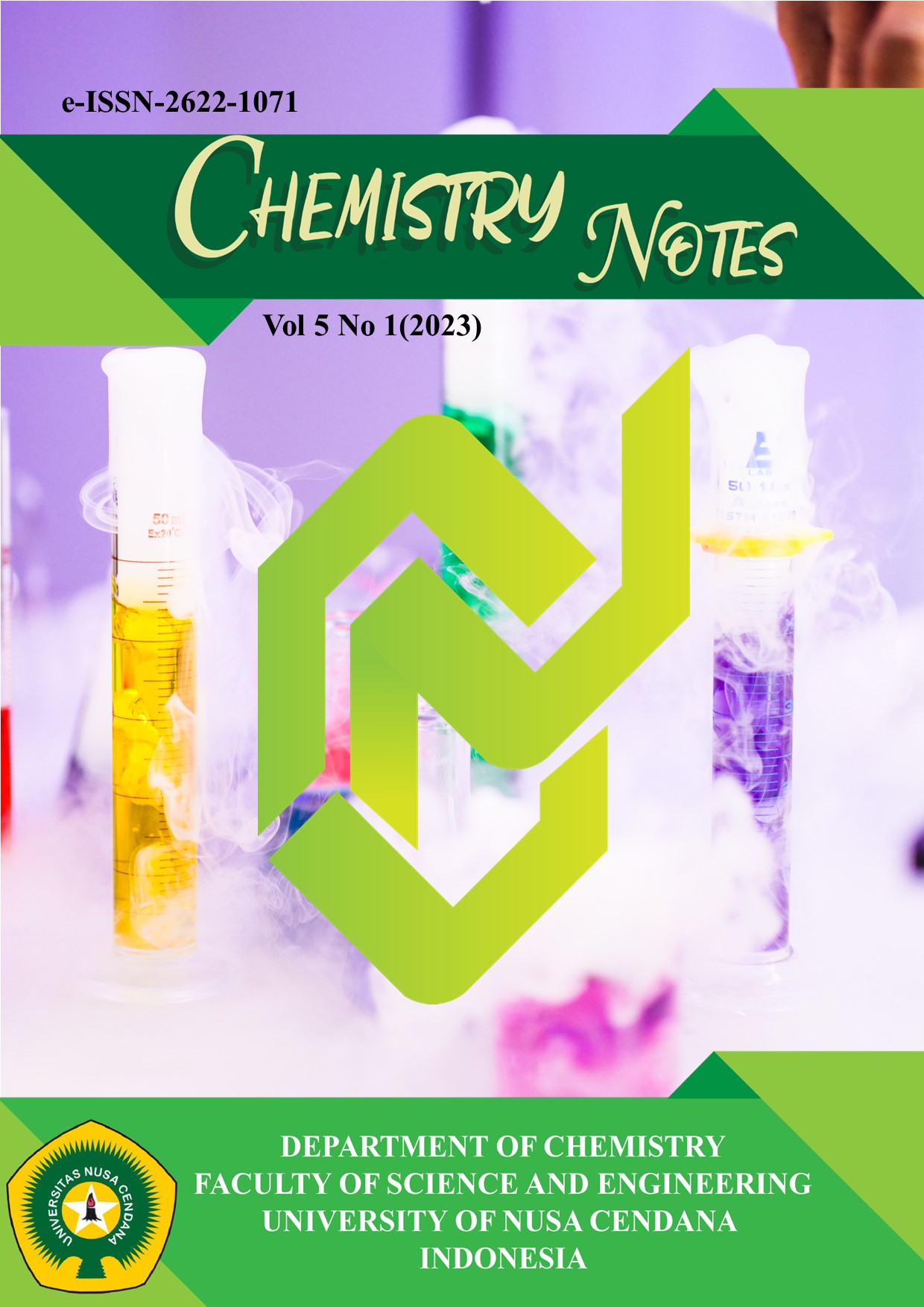PREPARATION OF ACTIVATED CHARCOAL FROM Terminalia catappa L. SEED SHELL AS AN ADSORBENT OF LIQUID WASTE OF TOFU INDUSTRY
Abstract
A research on preparing activated charcoal from Terminalia catappa L. seed shell has been done. This study aimed to determine the characteristics of activated charcoal from Terminalia catappa L.seed shells and test its ability to reduce COD and TSS from a liquid waste of the tofu industry. The parameters studied in characterizing activated charcoal included moisture content, ash content, absorption of I2 and surface area using methylene blue. Analysis of the COD parameter used the redox titration method, while the TSS parameter used the gravimetric method. he optimum time for applying activated charcoal to liquid tofu waste was by measuring COD and TSS levels after interaction with activated charcoal. Results of activated charcoal characterization showed a moisture content of 5%, ash content of 2.10%, an absorption capacity of I2 761.4 mg/g and a surface area of 26.74 m²/g. The highest decrease in COD levels occurred at 90 minutes of contact time from initial levels of 2,976 mg/L to 2,304 mg/L, with a reduction efficiency of 22.6%, and the highest decrease in TSS levels occurred at 90 minutes of contact time from initial levels of 1,440 mg/L to 334 mg/L, with a reduction efficiency of 76.8%. Generally, activated charcoal from Terminalia catappa L. seed shells showed an ability to reduce the COD and TSS from the liquid waste of the tofu industry.
Downloads
References
2. Rahayu, S. E. 2012. Teknologi Proses Produksi Tahu. Yogyakarta : Kanisius.
3. Kurnianto, E. 2017. Pengolahan Limbah Cair Tahu Dengan Penambahan kitosan Pada Reaktor Anaerob Dengan Variasi Waktu Tinggal. Jurnal Teknologi Lingkungan Lahan Basah. Pontianak : Prodi Teknik Lingkungan, Jurusan Teknik Sipil, Fakultas Teknik Universitas Tanjungpura. http://dx.doi.org/10.26418/jtllb.v5i1.18405
4. Pujiastuti, P. 2009. Perbandingan Efisiensi Teknologi Pengolahan Limbah Cair Industri Tahu Secara Aerasi; Flokulasi; Biofilter Anaerob Dan Biofilter Anaerob-Aerob Ditinjau Dari Parameter BOD5 Dan COD. Jurnal Ilmiah Biologi Dan Kesehatan. 2(1): 52-63. https://www.e-jurnal.com/2014/11/perbandingan-efisiensi-teknologi.html?m=1
5. Nastiti, S. L., Yuliani. & Fitrihidajati, H. 2015. Pemanfaatan Arang Aktif Limbah Kulit Kacang Kedelai (Glycine max) dalam Meningkatkan Kualitas Limbah Cair Tahu. FMIPA, Universitas Negeri Surabaya. https://ejournal.unesa.ac.id/index.php/lenterabio/article/view/10892/9844
6. Kasam, K. 2005. Penurunan COD (Chemical Oxygen Demand) dalam limbah cair laboratorium menggunakan filter karbon aktif arang tempurung kelapa. Logika. Vol.2. No.2 Jurusan Teknik Lingkungan FTSP UII. https://doi.org/10.20885/LOGIKA.VOL2.ISS2.ART1
7. Goa, A., Gauru. I., Solo. A., & Mere, J. 2015. Pembuatan Filter Ganda Mangan-Zeolit Dan Arang Aktif Tempurung Lontar Asal NTT Untuk Menurunkan Kadar Logam Fe Dan Mn Dalam Limbah Cucian Mangan Di Desa Noebesa Kabupaten Timor Tengah Selatan. Kupang: Jurusan Kimia, Fakultas Sains Dan Teknik, Universitas Nusa Cendana.
8. Alaerts, G., & Santika, S. S. 1984. Metode Penelitian Air Usaha Nasional. Surabaya: Hal.309.
9. Widhianti, D. W. 2010. Pembuatan arang aktif dari biji kapuk (ceiba pentandra L.) sebagai adsorben zat warna Rodhamin B. Skripsi. Universitas Airlangga. http://repository.unair.ac.id/id/eprint/25971
In order to publish in Chemistry Notes, authors are required to agree to the copyright permission stating that the authors give the publisher the right to reproduce, display or distribute the accepted manuscript. In this agreement the authors also automatically declare that the submitted manuscript is exempted from plagiarism issue and conflict of interest among the authors.

 Pius D. Ola(1*)
Pius D. Ola(1*)





